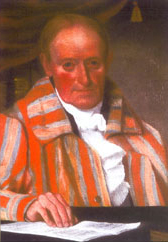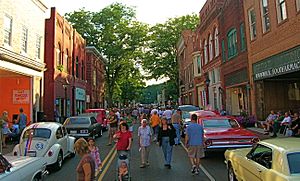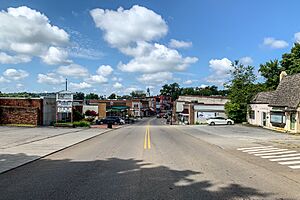Rogersville, Tennessee facts for kids
Quick facts for kids
Rogersville
|
|
|---|---|
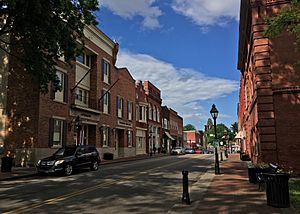
Downtown Rogersville in June 2020
|
|

Location in Hawkins County, Tennessee
|
|
| Country | United States |
| State | Tennessee |
| County | Hawkins |
| Settled | 1775 |
| Founded | 1789 |
| Incorporated | 1903 |
| Named for | Joseph Rogers |
| Government | |
| • Type | Mayor-council |
| Area | |
| • Town | 3.76 sq mi (9.73 km2) |
| • Land | 3.76 sq mi (9.73 km2) |
| • Water | 0.00 sq mi (0.00 km2) |
| Elevation | 1,312 ft (400 m) |
| Population
(2020)
|
|
| • Town | 4,671 |
| • Density | 1,242.62/sq mi (479.83/km2) |
| • Urban | 6,390 |
| Time zone | UTC−5 (Eastern (EST)) |
| • Summer (DST) | UTC−4 (EDT) |
| ZIP code |
37857
|
| Area code(s) | 423 |
| FIPS code | 47-64820 |
| GNIS feature ID | 2407236 |
Rogersville is a town in Hawkins County, Tennessee, United States. It is also the county seat, which means it's where the county government is located. The town was first settled in 1775 by the grandparents of Davy Crockett. It is named after its founder, Joseph Rogers.
Rogersville is home to some important "firsts" in Tennessee history. It has the state's second oldest courthouse, the Hawkins County Courthouse. It was also where Tennessee's first newspaper, The Knoxville Gazette, and first post office were located. The historic part of Rogersville is recognized on the National Register of Historic Places.
Rogersville is part of the Kingsport-Bristol-Bristol, TN-VA Metropolitan Statistical Area. This area is a key part of the larger Tri-Cities region. In 2020, about 4,671 people lived in Rogersville.
Contents
History of Rogersville
How Rogersville Was Settled
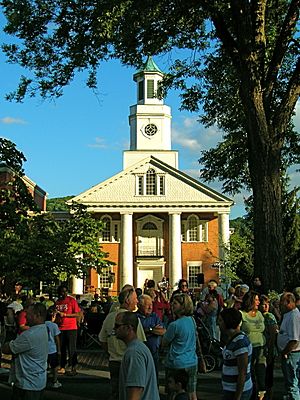
In 1775, the grandparents of Davy Crockett moved to this area. Davy Crockett later became a famous hero of the Alamo. They settled near a spring that is now named after the Crockett family. After a Native American attack, the Crockett family sold their land to Colonel Thomas Amis.
In 1780, Colonel Amis built a fort at Big Creek, just outside what is now Rogersville. He also built a strong stone house with a fence around it to protect against attacks. The next year, Amis opened a store, a blacksmith shop, and a place to make drinks. He also built a sawmill and a gristmill, which grinds grain. He even ran a place for travelers to stay.
The Town Begins
In 1785, a new state called the State of Franklin was formed. It decided that the government for Spencer County (which included Rogersville) would be in this area. Thomas Henderson became the county court clerk.
In November 1786, North Carolina took back control of the area. North Carolina created Hawkins County and chose the land owned by Joseph Rogers as the new county seat.
Joseph Rogers, the Founder
Joseph Rogers was born in Ireland in 1764. He came to this area, then known as the State of Franklin, by 1785. He met Mary Amis, Colonel Thomas Amis's daughter, at a tavern. They married in 1786. Mary's father gave Joseph the land near Crockett Spring. This was the same land Colonel Amis had bought from Davy Crockett's family.
When North Carolina was deciding where to put the Hawkins County government, Joseph Rogers worked hard to have it near his home. He offered his tavern, which he had opened around 1784, to be the first county courthouse in 1787. With help from other settlers, Rogers planned out the town. The town of Rogersville was officially created by North Carolina in 1789. The plan included a public square for a town well and a courthouse.
In 1792, Rogers became Rogersville's first postmaster. The town's second post office, built by Rogers around 1815, is still standing today. Joseph and Mary Rogers had fourteen children. Joseph died in 1833 and is buried in Rogers Cemetery.
Rogersville During the Civil War
In November 1863, during the American Civil War, a battle happened in Rogersville. Union soldiers were camped outside the town. Confederate troops, led by General William E. Jones, surprised the Union forces. The Confederates chased them across the Holston River. The Confederates then held the town for the rest of the war.
People in Rogersville had different opinions about the war. Many supported the Union, like other parts of East Tennessee. Others felt that President Abraham Lincoln's actions were an invasion of their homes and became strong Confederates. Luckily, Rogersville was not destroyed during the war. Buildings like the Hale Springs Inn were even used by both armies.
Rogersville's Printing History
George Roulstone was the first printer in Tennessee. He was encouraged to come to Rogersville by William Blount, the new governor. Roulstone printed Tennessee's first newspaper on November 5, 1791. It was called The Knoxville Gazette. He printed it near the Rogers tavern for about a year. In 1792, he moved his printing press to Knoxville.
After the Gazette moved, Rogersville didn't have a newspaper until 1813. Then, John B. Hood started The East Tennessee Gazette. Other newspapers soon followed, like The Western Pilot and The Rogersville Gazette.
Over the years, many other newspapers were published in Rogersville. Most of them lasted only a short time. Rogersville's longest-running newspaper is The Rogersville Review, which started in 1885.
You can learn about the town's printing history at the Tennessee Newspaper and Printing Museum. It's located in the old Southern Railway train depot, built around 1890.
Rogersville Today
In 2020, the Rogersville Town Council bought a three-acre site. They plan to build a new community center, town hall, and a concessions area for the town park there. This will create a new civic service campus for the community.
Geography and Climate
Where is Rogersville?
Rogersville is located a bit southwest of the center of Hawkins County. The town covers about 3.76 square miles of land. It sits in the valley of Crockett Creek, which flows into the Holston River. Rogersville is about 1,312 feet above sea level.
Using U.S. Route 11W, Rogersville is about 28 miles southwest of Kingsport. It is also about 65 miles northeast of Knoxville. Rogersville is in the Ridge-and-Valley Appalachians, which are part of the Appalachian Mountains.
Rogersville's Weather
| Climate data for Rogersville 1 NE, Tennessee (1991–2020 normals, extremes 1896–present) | |||||||||||||
|---|---|---|---|---|---|---|---|---|---|---|---|---|---|
| Month | Jan | Feb | Mar | Apr | May | Jun | Jul | Aug | Sep | Oct | Nov | Dec | Year |
| Record high °F (°C) | 80 (27) |
81 (27) |
86 (30) |
95 (35) |
96 (36) |
104 (40) |
102 (39) |
102 (39) |
103 (39) |
95 (35) |
84 (29) |
81 (27) |
104 (40) |
| Mean daily maximum °F (°C) | 45.3 (7.4) |
50.2 (10.1) |
59.1 (15.1) |
68.6 (20.3) |
76.2 (24.6) |
82.6 (28.1) |
85.5 (29.7) |
84.9 (29.4) |
80.4 (26.9) |
70.1 (21.2) |
58.2 (14.6) |
48.2 (9.0) |
67.4 (19.7) |
| Daily mean °F (°C) | 35.4 (1.9) |
39.4 (4.1) |
47.0 (8.3) |
56.3 (13.5) |
64.8 (18.2) |
71.8 (22.1) |
75.2 (24.0) |
74.2 (23.4) |
68.9 (20.5) |
57.6 (14.2) |
46.5 (8.1) |
38.5 (3.6) |
56.3 (13.5) |
| Mean daily minimum °F (°C) | 25.5 (−3.6) |
28.7 (−1.8) |
34.9 (1.6) |
44.1 (6.7) |
53.4 (11.9) |
60.9 (16.1) |
64.9 (18.3) |
63.5 (17.5) |
57.5 (14.2) |
45.2 (7.3) |
34.9 (1.6) |
28.8 (−1.8) |
45.2 (7.3) |
| Record low °F (°C) | −23 (−31) |
−17 (−27) |
−4 (−20) |
20 (−7) |
27 (−3) |
33 (1) |
44 (7) |
44 (7) |
31 (−1) |
16 (−9) |
5 (−15) |
−18 (−28) |
−23 (−31) |
| Average precipitation inches (mm) | 4.56 (116) |
4.17 (106) |
4.53 (115) |
4.54 (115) |
4.15 (105) |
4.40 (112) |
4.94 (125) |
3.22 (82) |
3.29 (84) |
2.73 (69) |
3.38 (86) |
4.93 (125) |
48.84 (1,241) |
| Average snowfall inches (cm) | 3.2 (8.1) |
2.1 (5.3) |
0.3 (0.76) |
0.0 (0.0) |
0.0 (0.0) |
0.0 (0.0) |
0.0 (0.0) |
0.0 (0.0) |
0.0 (0.0) |
0.0 (0.0) |
0.0 (0.0) |
0.7 (1.8) |
6.3 (16) |
| Average precipitation days (≥ 0.01 in) | 9.6 | 9.2 | 9.6 | 9.3 | 9.2 | 10.6 | 10.4 | 7.7 | 6.7 | 6.7 | 7.6 | 8.8 | 105.4 |
| Average snowy days (≥ 0.1 in) | 1.3 | 0.9 | 0.3 | 0.0 | 0.0 | 0.0 | 0.0 | 0.0 | 0.0 | 0.0 | 0.0 | 0.4 | 2.9 |
| Source: NOAA | |||||||||||||
Transportation in Rogersville
Main Roads
 US 11W, also known as Lee Highway.
US 11W, also known as Lee Highway.- Primary state highways:
 SR 70, called Trail of the Lonesome Pine.
SR 70, called Trail of the Lonesome Pine. SR 66.
SR 66.
- Secondary state highways:
 SR 1, the Memphis to Bristol Highway.
SR 1, the Memphis to Bristol Highway. SR 347.
SR 347.
Air Travel
The Hawkins County Airport is a public airport owned by the county. It is located about 7 miles northeast of downtown Rogersville.
People of Rogersville
| Historical population | |||
|---|---|---|---|
| Census | Pop. | %± | |
| 1870 | 657 | — | |
| 1880 | 740 | 12.6% | |
| 1890 | 1,153 | 55.8% | |
| 1900 | 1,386 | 20.2% | |
| 1910 | 1,242 | −10.4% | |
| 1920 | 1,402 | 12.9% | |
| 1930 | 1,590 | 13.4% | |
| 1940 | 2,018 | 26.9% | |
| 1950 | 2,545 | 26.1% | |
| 1960 | 3,121 | 22.6% | |
| 1970 | 4,076 | 30.6% | |
| 1980 | 4,368 | 7.2% | |
| 1990 | 4,149 | −5.0% | |
| 2000 | 4,240 | 2.2% | |
| 2010 | 4,420 | 4.2% | |
| 2020 | 4,671 | 5.7% | |
| Sources: | |||
Rogersville's Population in 2020
| Race | Number | Percentage |
|---|---|---|
| White (non-Hispanic) | 4,214 | 90.22% |
| Black or African American (non-Hispanic) | 149 | 3.19% |
| Native American | 11 | 0.24% |
| Asian | 35 | 0.75% |
| Other/Mixed | 168 | 3.6% |
| Hispanic or Latino | 94 | 2.01% |
As of the 2020 United States census, there were 4,671 people living in Rogersville. There were 1,767 households and 1,150 families.
Population Details
In 2000, there were 4,240 people in Rogersville. The town had 2,060 households. About 21% of households had children under 18. About 38.9% were married couples. The average household size was 1.97 people.
The population's age breakdown was:
- 17.8% under 18 years old.
- 8.0% from 18 to 24 years old.
- 23.2% from 25 to 44 years old.
- 24.8% from 45 to 64 years old.
- 26.2% were 65 years or older.
The average age was 46 years.
Culture and Events
Famous People from Rogersville
- Justice Sarah Keeton Campbell (born 1982): She became a Justice on the Tennessee Supreme Court in 2021. She moved to Rogersville at age eleven and went to Cherokee High School.
- Missy Testerman (born in the 1970s): She was named the 2024 National Teacher of the Year.
- Charlie Chase (born 1952): A radio and TV host famous for the show Crook & Chase in the 1990s.
- Commissioner Ken Givens (born 1947): He served as a State Representative and later as Tennessee's Commissioner of Agriculture. He grew up in Rogersville.
- General Ronald E. Brooks (1937–2018): A Major General in the U.S. Army during the Cold War. He was born and raised in Rogersville.
- Congressman William L. "Bill" Jenkins (born 1936): He was a U.S. Representative for Tennessee from 1997 to 2007. He grew up in Rogersville.
- Robert "Bob" Smith (1895–1987): A Major League Baseball player for teams like the Cincinnati Reds. He was born and raised in Rogersville.
- Richard Hale (1892–1981): An opera singer and actor known for films like To Kill a Mockingbird. He grew up in the town.
- Ruth Hale (1887–1934): A writer and women's rights activist. She was born and grew up in Rogersville.
- Senator George L. Berry (1882–1948): A labor union leader and U.S. Senator from Tennessee. He founded Pressmen's Home near Rogersville.
- General A.P. Stewart (1821–1908): A Confederate General during the Civil War. He later became president of the University of Mississippi.
- Congressman Samuel Powell (1776–1841): A U.S. Representative from Tennessee. He also served as a judge in Rogersville.
Town Events
- Heritage Days: This festival happens every second full weekend in October in downtown Rogersville.
- Fourth of July Celebration: A big celebration for Independence Day.
- Rogersville Holiday Festival: Includes a Holiday Tour of Homes in the Historic District and a Yule Log Ceremony.
Churches in Rogersville
Most churches in Rogersville are Christian. Some of the different types of Christian churches include:
- A.M.E. Zion
- Baptist
- Christian (Disciples of Christ)
- Churches of Christ
- Church of God
- Episcopal
- Jehovah's Witnesses
- Presbyterian
- Roman Catholic
- Seventh-day Adventist
- United Methodist
- United Pentecostal
Local Media
- The Rogersville Review: The local newspaper, started in 1885.
- WRGS AM 1370 Radio: Started in 1954.
- WRGS FM 94.5 Radio: Started in 2009.
- WEYE FM 104.3 Radio: Started in 1982, now broadcasts from nearby Surgoinsville.
Fun and Recreation
Rogersville City Park
The Rogersville City Park is in the eastern part of town. It's owned and run by the town.
The park has lots of things to do:
- Four children's playgrounds.
- Two outdoor basketball courts.
- Four outdoor tennis courts.
- Many picnic shelters.
- Three large, lighted pavilions (two with restrooms).
- An amphitheatre and a lighted stage.
- Six lighted baseball/softball fields.
- Soccer fields.
- A duck pond.
- A fitness trail and two walking trails.
The Rogersville City Pool is also here. It's open to the public from Memorial Day until school starts in August. The park hosts a traveling carnival in spring and fall. It also welcomes over fifty thousand people for the Fourth of July celebration. In September 2023, the park received a grant to add new restrooms and upgrade playground equipment.
Crockett Spring Park
Crockett Spring Park is in downtown Rogersville. It's a project by the town and the Rogersville Heritage Association. This park is where Rogersville was first settled. Joseph Rogers's original tavern and home are preserved here. The park also includes the Rogers Cemetery, where Joseph and Mary Rogers are buried. Davy Crockett's grandparents are also buried here.
The park has a gazebo built to celebrate the town's 200th birthday (1989) and Tennessee's 200th birthday (1996).
Swift Memorial Park
Rogersville was once home to Swift College, a college for African-American students in the late 1800s and early 1900s. Swift Park remembers this college. The park has picnic shelters, two playgrounds, and basketball courts.
Education in Rogersville
Rogersville has two school districts. Elementary students attend Rogersville City Schools. Older students (middle and high school) attend Hawkins County School District schools.
Rogersville City Schools
- Rogersville Elementary School: This school serves students from PreK through 8th grade. It started in its current form in 1950. Their mascot is the Warrior, and their colors are red, white, and black. In 2007, the Warriors football team won the state championship!
Hawkins County School District
- Cherokee Comprehensive High School: This is the high school for students in grades 9-12. It opened in 1981. Their mascot is the Chief, and their colors are red, black, and white.
- Rogersville Middle School: This school serves grades 6-8. Their mascot is the Warrior, and their colors are maroon and gray.
- Hawkins Elementary School: This school serves grades 3-5. Their mascot is the Bearcat, and their colors are light blue and gold.
- Joseph Rogers Primary School: This school serves grades K-2. Their mascot is the Bobcat. This school is near, but not inside, the Rogersville city limits.
See also
 In Spanish: Rogersville (Tennessee) para niños
In Spanish: Rogersville (Tennessee) para niños


